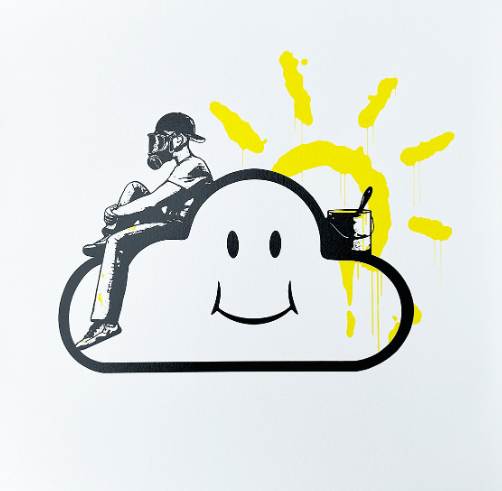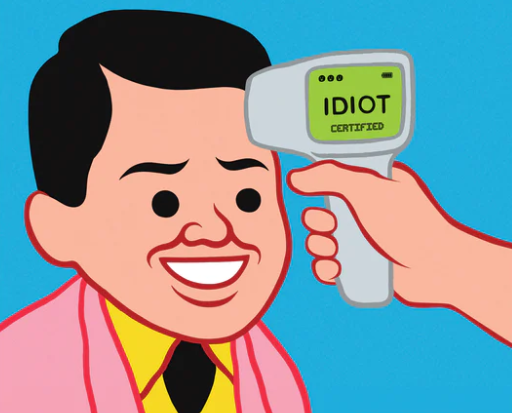
Smile
-

Joan Cornellà Idiot Giclee Print by Joan Cornellà
Idiot Giclee Print by Joan Cornellà Artwork Limited Edition Print on Archival Textured Fine Art Paper Graffiti Pop Street Artist. 2023 Signed & Numbered Limited Edition of 100 Artwork Size 25.59x21.25 Idiot Giclee Print by Joan Cornellà Idiot is a 2023 limited edition giclee print by renowned street pop artist Joan Cornellà. Signed and numbered, this piece is part of a collection of 100 prints, created on archival textured fine art paper. Measuring 25.59x21.25 inches, the artwork showcases Cornellà's distinctively humorous and absurd style, often characterized by simplistic cartoon figures and dark satirical themes. The image depicts a smiling man being scanned with a thermometer-like device reading "Idiot Certified," creating an immediate visual punch and exemplifying Cornellà’s signature approach to challenging societal norms. Joan Cornellà's Approach to Satire in Street Pop Art Joan Cornellà, a Spanish-born artist, is widely known for his minimalist, absurdist cartoons that take a critical look at modern society. His work frequently uses humor, often dark and uncomfortable, to shine a spotlight on the trivialities and absurdities of human behavior. Idiot is no exception, and in this print, Cornellà uses simple lines and bright colors to convey a biting critique on the ease with which society labels individuals, often without deeper understanding or nuance. Cornellà’s characters typically have smiling, vacant expressions, which only serves to heighten the absurdity of their situations. In Idiot, the juxtaposition of the smiling man with the thermometer reading “Idiot Certified” suggests a satirical commentary on the superficial judgments people face in a world driven by appearances and quick assessments. The "certification" of idiocy highlights the ridiculousness of relying on superficial indicators or societal validation to define self-worth or intelligence. This kind of critique is a hallmark of street pop art, where everyday symbols and elements are often recontextualized to critique social behavior and norms. The use of minimalistic, flat designs is a stylistic choice that enhances the immediacy of the message. Cornellà uses a bold color palette and simple lines to make the work visually striking, creating an art piece that immediately grabs attention while allowing viewers to quickly grasp its satirical meaning. The exaggerated, cartoon-like figures may appear simple at first glance, but they carry complex undertones about the human condition and the absurdity of modern societal structures. The Role of Dark Humor in Cornellà's Graffiti and Pop Art Cornellà’s work has been likened to graffiti and street pop art in that it distills complex social critiques into instantly recognizable images. His use of dark humor—a staple of his work—sets him apart within the pop art landscape. Idiot relies on a form of humor that is both biting and subtle, allowing viewers to laugh at the absurdity of the situation while recognizing the deeper societal issues being critiqued. The simplicity of the image belies the complexity of its social commentary, offering layers of interpretation. In street pop art, humor is often used as a tool to subvert traditional art norms or challenge authority. Cornellà's approach can be seen as a continuation of this tradition, where humor acts as a vehicle to critique social, political, and cultural systems. The absurdity in Idiot draws attention to how people often willingly conform to ridiculous standards without question. It reflects the increasingly superficial nature of society, where quick judgments based on surface-level interactions—much like a thermometer scan—can lead to reductive, often harmful, labels. The use of a medical device to certify idiocy also evokes a commentary on the over-reliance on technology or systems that dehumanize people. Cornellà’s work often critiques the technological and bureaucratic systems that strip individuals of their humanity, reducing them to a set of labels or metrics. This resonates with the broader themes in street pop art and graffiti, where artists often challenge the dehumanizing aspects of modern life, from politics to mass surveillance. Giclee Print as a Modern Medium for Street Pop Art The choice of giclee printing for Idiot aligns with the artist’s commitment to quality and the longevity of his artwork. Giclee printing is a process that uses high-resolution digital images and archival inks to create prints that are as close to the original as possible. This method ensures that the vibrant colors and sharp lines in Cornellà’s work are preserved over time. The use of archival textured fine art paper further enhances the print’s quality, providing a tactile, almost painterly feel to the image. Giclee printing is often used by modern street pop artists who want to maintain the integrity of their work while making it more accessible to collectors. In the case of Idiot, the giclee print allows Cornellà’s satirical cartoon to be appreciated in a physical format that retains all of the detail and color of the original digital design. By producing a limited edition of 100, Cornellà ensures that the artwork remains exclusive, while still making it available to a wider audience. In street pop art, the medium is often just as important as the message. By using high-quality printing techniques, Cornellà ensures that his satirical message—both humorous and critical—can stand the test of time, while also contributing to the ongoing conversation about what constitutes fine art in the context of street art and graffiti. The print is both a collectible item and a work of art with a strong social message. The Role of Social Commentary in Joan Cornellà's Artwork Cornellà’s artwork often revolves around themes of identity, societal expectations, and the absurdity of modern life. Idiot is a perfect example of how Cornellà uses simple imagery to dissect these complex ideas. The smiling man in the image, unperturbed by his "certified" idiocy, reflects the way individuals can become complicit in their own dehumanization by accepting societal labels. Cornellà’s work frequently critiques how people allow themselves to be categorized and diminished, all while maintaining a cheerful or passive demeanor. The absurdity of the situation is heightened by the fact that the character being labeled an "idiot" seems entirely unaware or unconcerned by the judgment being passed. This plays into Cornellà’s larger body of work, where individuals are often depicted as detached from the consequences of their actions or the systems that control them. In street pop art, this detachment is a common theme, reflecting how urban environments and societal structures can alienate individuals from themselves and each other. Idiot by Joan Cornellà is a masterful example of how street pop art and graffiti-inspired artwork can blend humor, absurdity, and critical social commentary. Through the use of minimalistic design, bright colors, and satirical humor, Cornellà challenges viewers to question how society defines intelligence, self-worth, and identity. The high-quality giclee print on archival fine art paper ensures that this artwork will remain a lasting and impactful piece within the world of contemporary art.
$4,750.00 $4,038.00


